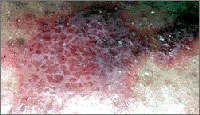What is Lichen Planus?
What is Lichen Planus?
 Lichen Planus, an obstinate skin disorder, has baffled the patients and the practitioners equally. The cases of Lichen Planus have been observed worldwide, irrespective of race, skin color, and culture. The medical field today finds little help for this chronic disease. Fortunately, homeopathy, the fast-growing alternative medicine, has a definite, promising treatment for Lichen Planus. Most people do not hear about Lichen Planus until they are diagnosed having it, as it is not much spoken about.
Lichen Planus, an obstinate skin disorder, has baffled the patients and the practitioners equally. The cases of Lichen Planus have been observed worldwide, irrespective of race, skin color, and culture. The medical field today finds little help for this chronic disease. Fortunately, homeopathy, the fast-growing alternative medicine, has a definite, promising treatment for Lichen Planus. Most people do not hear about Lichen Planus until they are diagnosed having it, as it is not much spoken about.
Lichen Planus is commonly misspelled as lichen planu, liche planus, licchen planus, or liken planus. Lichen Planus is called Daad in Hindi and Gajkarna in Marathi.
It is a long-standing (chronic), recurring, non-allergic, non-infectious, non-contagious disease of the skin, of which the exact cause is not yet fully understood.
It can affect the skin, oral mucosa, tongue, scalp, genitals, and nails. However, it is less likely that it affects all the areas as stated simultaneously. It has a tendency to relapse after some months or years. Females are more frequently affected than their male counterparts; however, it is uncommon to find it in children. Over 1.9% of the total population is affected by Lichen Planus.
Please examine this photo to check the typical skin lesions of Lichen Planus. The images can be clicked to enlarge to have a better view.
These web pages have been offering a huge amount of information on Lichen Planus since 1996, based on a significant experience of treating and managing this disease, including all of its variants. Incidentally, some information we have derived from our experience may not be found in the standard medical textbooks.
Some variants of Lichen Planus are easier treated as compared to others. Also, the prognosis also depends on the combination of locations of Lichen Planus.
Signs and symptoms of Lichen Planus:
 The typical appearance of the Lichen Planus eruption is a round or irregular shape, raised slightly above the skin level, brown, pinkish, or black in color.
The typical appearance of the Lichen Planus eruption is a round or irregular shape, raised slightly above the skin level, brown, pinkish, or black in color.
Commonly Affected Parts in Lichen Planus
Lichen Planus largely affects the skin. It may also affect the mouth (gums, tongue, and palate) (oral Lichen Planus), the scalp, nails, or the genitals (glans, penis). It could affect one or more of the said body parts. It is not a rule that every patient with Lichen Planus will have all the said areas affected. In males, it could affect the glans of the penis, and in females, the vulva or vagina. It can
be said that more areas affected, more challenging to treat. Also, experience says that the oral or genital Lichen Planus is more difficult to treat than that on the skin. Also, Lichen planus affecting the scalp when scarring may lead to permanent hair loss, which is difficult to treat.
The typical textbook description goes:
Flat-topped shiny polygonal eruptions. Small in size, thickened eruptions, rough and oily to touch, dirty look at times. You may find spots either in groups, a few or numerous in number, and very often bilateral symmetrical (on both sides of the body, say legs).
 Clinically, a peculiar appearance classically described as Wickham's striae is considered Lichen Planus diagnostic.
Clinically, a peculiar appearance classically described as Wickham's striae is considered Lichen Planus diagnostic.
Please see the picture above.
Under the microscope: It is less important for the patients to know how Lichen Planus tissues look when seen under the microscope. Following is the microscopic (histopathological) view of it.
 At times, one also observes the Lichen Planus eruptions appearing along the line of a scratch mark, called Koebner's phenomenon. It has an affinity for the genitals involved. In males, the glans, while the vulva may be affected in females.
At times, one also observes the Lichen Planus eruptions appearing along the line of a scratch mark, called Koebner's phenomenon. It has an affinity for the genitals involved. In males, the glans, while the vulva may be affected in females.
The nails, when affected, tend to become deformed. In short, Lichen Planus affecting the skin, mouth (Oral Lichen Planus), and vaginal LP are some of the most common variants. When the oral mucosa or the genitals are affected, this condition is often neglected, reported late, or incorrectly diagnosed. Lichen Planus involving the food pipe (esophagus) is not commonly encountered. However, some cases have been reported at some institutes.
All variants of L ichen Planus respond very well to homeopathic treatment. It can be said with confidence that Lichen Planus is curable using homeopathy. Homeopathy offers excellent results in the Lichen Planus of the skin, mouth, and genitals, in this order.
ichen Planus respond very well to homeopathic treatment. It can be said with confidence that Lichen Planus is curable using homeopathy. Homeopathy offers excellent results in the Lichen Planus of the skin, mouth, and genitals, in this order.
Lichen Planus after stretch marks:
One of the recent cases documented at Life Force has displayed the occurrence of Lichen Planus after stretch marks (striae) on losing weight. This is called the Koebner phenomenon. The Koebner phenomenon denotes the development of Lichen planus after trauma to the skin.

.gif)
Written & Approved by-
Dr. Rajesh Shah
M.D. (Hom.)